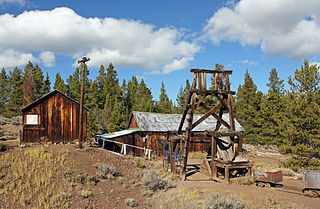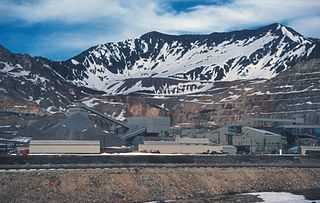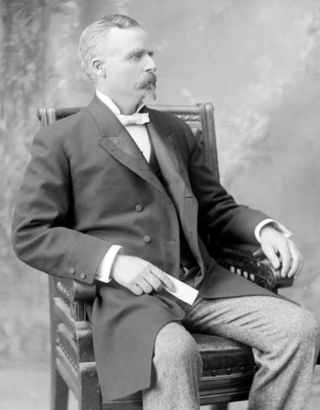
Winfield Scott Stratton was an American prospector, capitalist, and philanthropist. He discovered the Independence Lode near Victor, Colorado on July 4, 1891, and became the Cripple Creek Mining District's first millionaire in 1894. He provided to build buildings, improve the street car system, build the first professional ball park, and provided funds to people in need.

The City of Leadville is a statutory city that is the county seat, the most populous community, and the only incorporated municipality in Lake County, Colorado, United States. The city population was 2,602 at the 2010 census and an estimated 2,762 in 2018. It is situated at an elevation of 10,158 feet (3,096 m). Leadville is the highest incorporated city in the United States and it is surrounded by two of the tallest 14,000 foot peaks in the state.

The Colorado Silver Boom was a dramatic expansionist period of silver mining activity in the U.S. state of Colorado in the late 19th century. The boom started in 1879 with the discovery of silver at Leadville. Over 82 million dollars worth of silver was mined during the period, making it the second great mineral boom in the state, and coming 20 years after the earlier and shorter Colorado Gold Rush of 1859. The boom was largely the consequence of large-scale purchases of silver by the United States Government authorized by Congress in 1878. The boom endured throughout the 1880s, resulting in an intense increase in both the population and wealth of Colorado, especially in the mountains. It came to an end in 1893 in the wake of the collapse of silver prices caused by the repeal of Sherman Silver Purchase Act.

Philip Deidesheimer was a mining engineer in the Western United States.
Isaac Tyson Jr. (1792–1861) was a Quaker businessman from Baltimore, Maryland, who held a virtual monopoly on world supplies of chromium minerals during the mid-19th century and a very successful entrepreneur and industrialist.

Granite is an unincorporated community with a U.S. Post Office in Chaffee County, Colorado, United States. The zip code of Granite is 81228. According to the 2010 census, the population is 116.
Gold mining in Colorado, a state of the United States, has been an industry since 1858. It also played a key role in the establishment of the state of Colorado.
Silver mining in Colorado has taken place since the 1860s. In the past, Colorado called itself the Silver State.

Oro City is a ghost town in Lake County, Colorado, United States

John Munro Longyear, Sr. was an American businessman and noted developer of timber and mineral lands in the Upper Peninsula of Michigan who became the central figure behind the Arctic Coal Company, which surveyed and mined coalfields on Spitsbergen, now Svalbard, from 1905 to 1916. This company developed a settlement on Spitsbergen able to accommodate up to around 500 people which became known as Longyear City, now Longyearbyen, adjacent Advent Bay.

The Mineral Belt National Recreation Trail is an 11.6 mile all-season biking/walking trail that loops around Leadville, Colorado and through its historic mining district. The trail's setting is quintessentially Colorado Rocky Mountain landscape. Groves of aspen, conifer forests, wildflower meadows, and open vista sage parks are interspersed with once-booming mine sites. Ever-present views of the Sawatch and Mosquito mountain ranges provide perspective and a sense of permanence to the area. Several signs along the way provide historical snippets about Leadville's colorful past. The trail is designed for bicycles, longboards, walkers, wheelchairs, strollers and in-line skaters. When the snow falls, snowcats groom the trail to provide access to Nordic skiers, snowshoers and winter-bikers.

The Leadville mining district, located in the Colorado Mineral Belt, was the most productive silver-mining district in the state of Colorado and hosts one of the largest lead-zinc-silver deposits in the world. Oro City, an early Colorado gold placer mining town located about a mile east of Leadville in California Gulch, was the location to one of the richest placer gold strikes in Colorado, with estimated gold production of 120,000–150,000 ozt, worth $2.5 to $3 million at the then-price of $20.67 per troy ounce.

The Climax mine, located in Climax, Colorado, United States, is a major molybdenum mine in Lake and Summit counties, Colorado. Shipments from the mine began in 1915. At its highest output, the Climax mine was the largest molybdenum mine in the world, and for many years it supplied three-fourths of the world's supply of molybdenum.

John Francis Campion was a wealthy Canadian-American who made his fortune in mining and sugar production. He was also an executive and investor in banking, railroad, insurance, and other businesses.

The 1892 Coeur d'Alene labor strike erupted in violence when labor union miners discovered they had been infiltrated by a Pinkerton agent who had routinely provided union information to the mine owners. The response to the labor violence, disastrous for the local miners' union, became the primary motivation for the formation of the Western Federation of Miners (WFM) the following year. The incident marked the first violent confrontation between the workers of the mines and their owners. Labor unrest continued after the 1892 strike, and surfaced again in the labor confrontation of 1899.
Mining in the United States has been active since the beginning of colonial times, but became a major industry in the 19th century with a number of new mineral discoveries causing a series of mining rushes. In 2015, the value of coal, metals, and industrial minerals mined in the United States was US $109.6 billion. 158,000 workers were directly employed by the mining industry.
The Leadville Blues were a minor league baseball team based in Leadville, Colorado. Between 1885 and 1898, Leadville teams played as members of the 1885 Colorado State League, 1886 Western League and Colorado State League in 1889, 1896 and 1898. The 1896 team was known as the Leadville "Angels." The Blues and Angels hosted minor league home games at the Leadville Base Ball Grounds.
Prospectors is a weekly American reality television series that aired from March 26, 2013, to February 14, 2016, on The Weather Channel. The show follows miners in the Colorado Rocky Mountains as they search for precious metals and gemstones.

Gertrude Selma Sober Field was an American geologist and mining company executive, credited with discovering the zinc in the Arbuckle Mountains in Oklahoma. She was called "Queen of the Arbuckles", and inducted posthumously into the National Mining Hall of Fame in 1988.

John Lewis Dyer (1812-1901), "The Snowshoe Itinerant," was a circuit rider, that is, a preacher who rode from one church to the next. He was a Methodist.


















